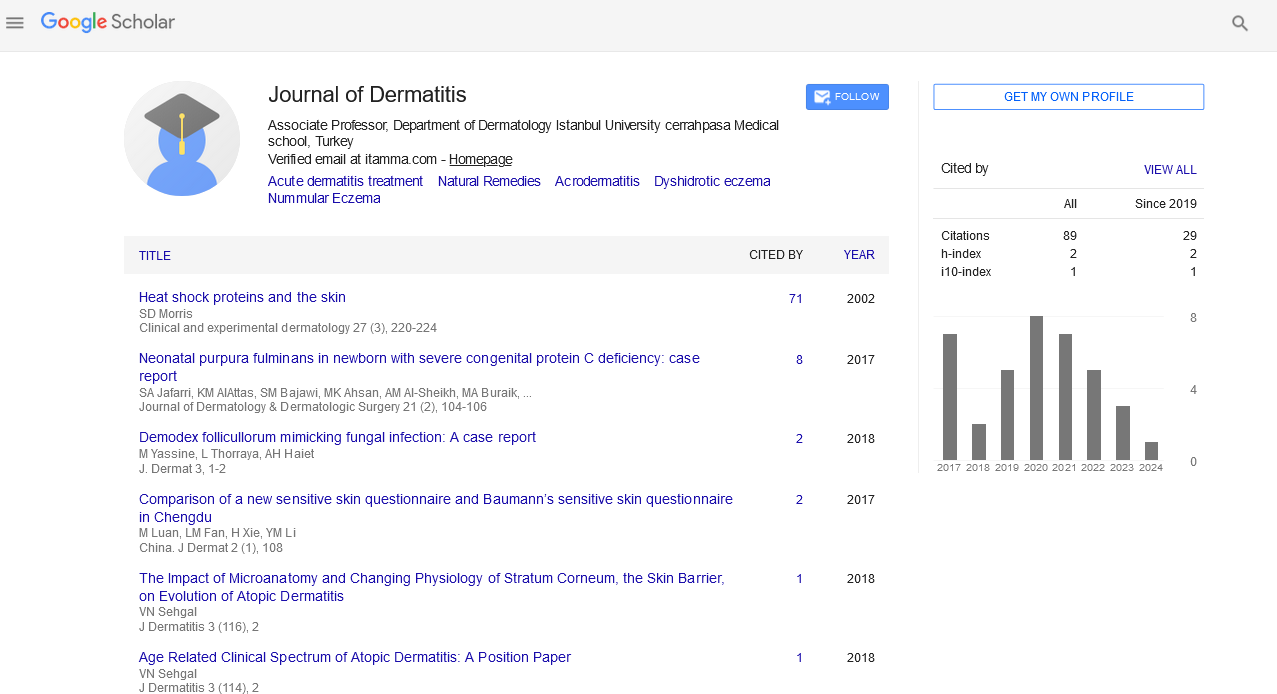Indexed In
- RefSeek
- Hamdard University
- EBSCO A-Z
- Euro Pub
- Google Scholar
Useful Links
Share This Page
Journal Flyer

Open Access Journals
- Agri and Aquaculture
- Biochemistry
- Bioinformatics & Systems Biology
- Business & Management
- Chemistry
- Clinical Sciences
- Engineering
- Food & Nutrition
- General Science
- Genetics & Molecular Biology
- Immunology & Microbiology
- Medical Sciences
- Neuroscience & Psychology
- Nursing & Health Care
- Pharmaceutical Sciences
Opinion Article - (2023) Volume 8, Issue 5
Complex Mechanisms of Skin Inflammation and Treatment Strategies
Kuanbo Tanzil*Received: 17-Aug-2023, Manuscript No. JOD-23-23484; Editor assigned: 21-Aug-2023, Pre QC No. JOD-23-23484 (PQ); Reviewed: 04-Sep-2023, QC No. JOD-23-23484; Revised: 11-Sep-2023, Manuscript No. JOD-23-23484 (R); Published: 19-Sep-2023, DOI: 10.35248/2684-1436.23.8.216
Description
Skin inflammation, a common dermatological concern, occurs when the body's immune response is triggered by various factors, leading to redness, swelling, itching, and discomfort. Understanding the mechanisms behind skin inflammation is pivotal for effective treatment and management. This explores the intricate processes involved in skin inflammation, illuminate on its causes, symptoms, and potential treatment strategies.
Inflammatory triggers
Skin inflammation can be triggered by a variety of factors, including infections, allergies, irritants, autoimmune disorders, and even genetic predisposition. Common causes include bacterial or fungal infections, contact dermatitis (resulting from exposure to irritants like chemicals or allergens), psoriasis, eczema, and insect bites. These triggers prompt the immune system to react, setting off a cascade of events leading to inflammation.
Immune response
The skin serves as the body's first line of defense against external threats. When it detects an intruder, such as bacteria or allergens, it signals the immune system to respond. This process involves white blood cells, such as neutrophils and macrophages, which migrate to the affected area to neutralize the threat. These immune cells release inflammatory mediators like cytokines and chemokines to attract more immune cells to the site of infection or irritation.
Inflammatory mediators
Cytokines and chemokines play a pivotal role in the inflammatory response. Cytokines are signaling proteins that regulate immune cell communication, while chemokines attract immune cells to the site of inflammation. The release of these mediators leads to increased blood flow, causing redness and warmth, and permeability of blood vessels, resulting in swelling.
Additionally, prostaglandins and leukotrienes are lipid compounds that contribute to pain and itchiness during inflammation.
Cellular involvement
Neutrophils are the first responders during skin inflammation. They engulf and destroy pathogens and release enzymes that break down damaged tissue. Macrophages arrive later and continue to eliminate pathogens and cellular debris. These immune cells produce reactive oxygen species (ROS) to aid in pathogen destruction but can also cause tissue damage if not regulated.
Inflammatory skin disorders
Several skin conditions are associated with chronic inflammation. Psoriasis, for example, is an autoimmune disorder characterized by the overproduction of skin cells and a rapid turnover rate. Eczema, or atopic dermatitis, results from a malfunction in the skin barrier and is marked by itching, redness, and inflammation. Rosacea is another chronic skin condition characterized by facial redness, visible blood vessels, and pimple-like bumps.
Treatment strategies
Treatment for skin inflammation depends on its cause and severity. For acute cases caused by allergies or irritants, topical corticosteroids or antihistamines may be prescribed to reduce inflammation and itching. In cases of bacterial or fungal infections, antimicrobial agents like antibiotics or antifungals are used. For chronic conditions like psoriasis or eczema, treatment may involve immunosuppressive medications, phototherapy, or biologics to modulate the immune response.
Preventive measures
Preventing skin inflammation is possible by minimizing exposure to known triggers. For example, using hypoallergenic skincare products and avoiding harsh chemicals can help prevent contact dermatitis. Practicing good hygiene and promptly treating wounds can reduce the risk of infection-related inflammation. For individuals with chronic skin conditions, managing triggers and adhering to prescribed treatments are essential for long-term control.
Conclusion
Skin inflammation is a complex process involving various triggers, immune responses, and cellular interactions.
Understanding the mechanisms behind skin inflammation is vital for effective management and treatment. By identifying and addressing the underlying causes and triggers, individuals can reduce the frequency and severity of skin inflammation, improving their overall skin health and quality of life. If patient experience persistent or severe skin inflammation, consult a dermatologist for a proper diagnosis and treatment plan with specific needs.
Citation: Tanzil K (2023) Complex Mechanisms of Skin Inflammation and Treatment Strategies. J Dermatitis. 8:216.
Copyright: © 2023 Tanzil K. This is an open-access article distributed under the terms of the Creative Commons Attribution License, which permits unrestricted use, distribution, and reproduction in any medium, provided the original author and source are credited.

